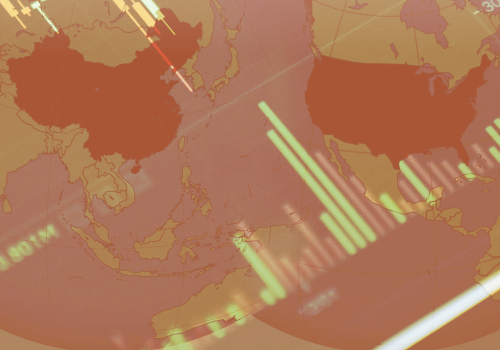Fragmentation and the role of the IMF
The global economy and international financial system have evolved dramatically since the founding of the Bretton Woods system in 1944. A trend toward greater trade openness defined the decades following the establishment of the system. And while the Bretton Woods arrangement of fixed exchange rates was abandoned in 1973, this new international economic order continued to facilitate global economic integration and financial liberalization. Yet the trend of ever-more globalization, which has largely defined the past fifty years, appears to have stalled. Trade openness has remained effectively flat since the global financial crisis (GFC) (figure 1a), while cross-border assets have trended down or sideways since the COVID-19 pandemic and Russia’s 2022 invasion of Ukraine (figure 1b).
By fostering financial stability and supporting economic growth, the International Monetary Fund (IMF) provided a stable foundation which supported this trend of increased cross-border trade and investment. The IMF, through its surveillance and lending operations, was established to act as an impartial referee to ensure that member countries pursued sound economic and financial policies. It also expanded the global financial safety net (GFSN) – which acts as an insurance mechanism to provide liquidity to countries facing economic crises. The IMF, as the lender of last resort to the global economy, acted as the primary provider of crisis support up until the GFC.
This postwar system, of which the IMF was a core component, supported decades of economic prosperity, broad-based increases in living standards, and a marked decline in global poverty rates. However, the global economy had no shortage of crises in the intervening years. Experiences ranging from the Latin American debt crisis to the Asian financial crisis have incrementally eroded the IMF’s credibility and led member countries to seek alternative insurance mechanisms that do not come with “strings attached” (e.g., IMF program conditionality), thereby reducing member countries’ reliance on the IMF.
The onset of the GFC led countries to double down on self-insurance mechanisms. It also led to a substantial diversification of the GFSN, as bilateral swap lines (BSL) and regional financing arrangements (RFA) overtook the size of IMF resources in the safety net. To safeguard economic stability and protect against external shocks in the wake of the GFC, country authorities enacted capital controls, referred to as capital flow management measures (CFMs) in IMF parlance, in addition to accumulating foreign exchange reserves. This use of CFMs and international reserves as a self-insurance mechanism was further amplified by the COVID-19 pandemic and its associated financial distress.
Now, following the economic and financial disruptions stemming from Russia’s invasion of Ukraine and rising geopolitical tensions, countries are increasingly utilizing industrial policies and current account restrictions to direct and manage trade flows as well – a trend that is best illustrated by the broad threat (and imposition) of tariffs that President Trump has made during the first month of his second term. These restrictions on capital and trade flows have contributed to the stalling of global integration and will likely result in greater volatility across the global economy in the coming years. Moreover, the displacement of the IMF as the anchor of the GFSN calls into question whether the GFSN can and will provide equitable support to all countries facing economic crises. As the global economy and international financial system enter a new era—characterized by increasing fragmentation rather than integration—ensuring that the international system has an effective insurance mechanism is more important than ever.
This report is organized as follows. In Section II, I document the rise in fragmentation across capital and trade flows. Section III discusses how the emergence of these fragmentary forces has coincided with changes in the size and composition of the GFSN. Section IV explores how these forces of fragmentation could affect global development prospects and financial stability at the country- and system-level. Section V concludes with policy recommendations to revitalize the IMF and preserve the core insurance mechanism which underpins global development and financial stability.
About the author
Patrick Ryan is a Bretton Woods 2.0 Fellow with the Atlantic Council’s GeoEconomics Center.
Our work

At the intersection of economics, finance, and foreign policy, the GeoEconomics Center is a translation hub with the goal of helping shape a better global economic future.
Related content
Image: An illustration of the International Monetary Fund headquarters is pictured.

